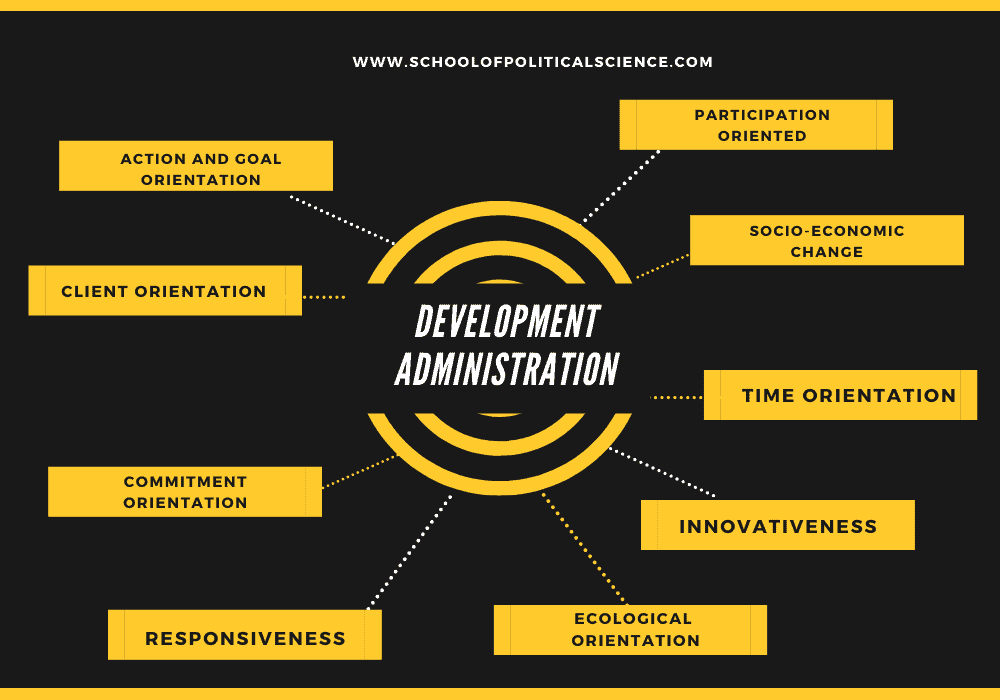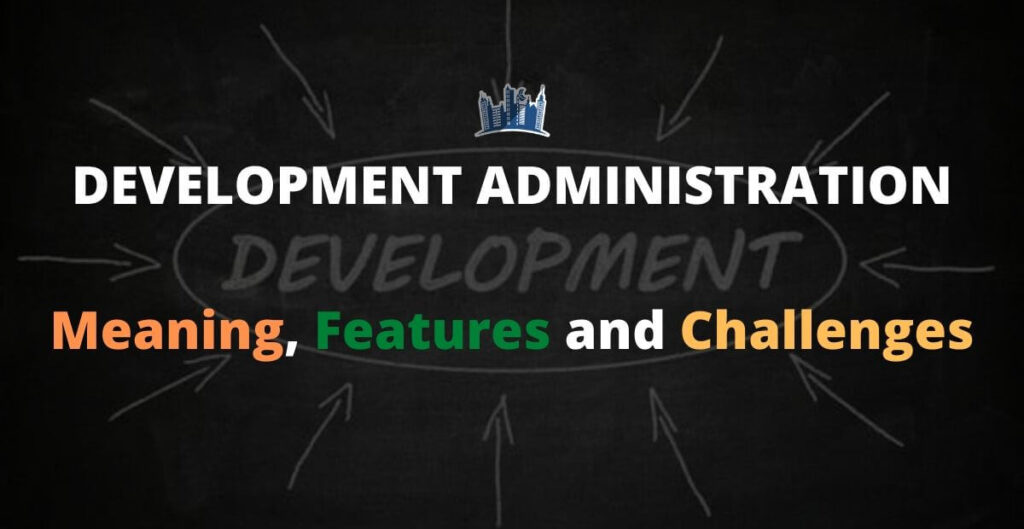Development administration is the process of executing developmental programs and projects in the direction of nation-building and socio-economic progress through public administration. There are two main issues identified as development administration goals –
- Nation-building and
- Socio-economic development.
The term ‘development administration was first coined in 1955 by an Indian scholar U.L Goswami in his writing “The Structure of Development Administration in India”.

Edward Weidner is the first scholar who gave a proper systematic explanation of the development administration. According to him, development administration is “an action-oriented, goal-oriented administrative system…guiding an organization towards the achievement of progressive political, economic and social objectives”.
Other contributors to development administration are George F. Gant, F.W. Riggs, Han Bee Lee, John D. Montgomery, and Alfred Diamant.
Emerging Factors of Development Administration
Professor Chakrabarty and Chand have mentioned three major factors for the emergence and growth of development administration.
- The emergence of newly decolonized nations after the Second World War.
- The emergence of international and the US economic and technical plans for assistance to developing nations. And
- The establishment of the Comparative Administrative Group and the interest shown by its members in developing nations and their administrative systems.
After World War II, most of the countries in Asia and Africa gained independence from colonial rule. As a result of the long period of colonial rule, the newly independent states faced many problems. Economic problems cover a large part of their miscellaneous problems. Poverty, malnutrition, starvation, and lack of housing were the burning problems of these states. Other social problems were associated with it.
Must Read- Meaning Nature And Scope of Public Administration
The lack of efficiency of the political parties up to the grassroots level and the absence of pressure groups are noticeable in these countries to get out of such a situation.
Therefore, this responsibility was entrusted to the public administration. Because of the long period of colonial rule, the bureaucratic institutions in these countries were well-established.
As a result, most states survive the bureaucracy in order to take on the main responsibility for social change. It was thought that all development projects should be implemented through public administration. This is how developmental administration emerged.
Must Read- 5 Phases Of The Evolution Of Public Administration
The largest contributor to the development administration is the United States Comparative Public Administration Group (CAG). Fred Riggs was chairman of the group from 1960 to 1970.
Under his supervision, a group of researchers studied the administration of developing countries in Asia and Africa. In this way, a new aspect of public administration was developed.
Features of Development Administration

The following features of development administration can be identified –
- Action and Goal Orientation
Development administration is action as well as goal-oriented. This means that it is related to achieving certain programmatic results. Developing countries need to address socio-economic problems, and this is exactly why development goals are set and development administrations take action towards those goals.
- Socio-economic change
Development administration is also change-oriented. Here change means the socioeconomic change in underdeveloped or developing countries. So, development administration is concerned with bringing socio-economic development.
- Client Orientation
It has to do with satisfying the needs of its clients. The need for clients means the need for citizens. It is concerned with the uplift of the poorer section of the society.
Almost every country announces various schemes for the betterment of the lower class or community in the society and all those schemes are managed by the public administration and this kind of administration is called client-based development administration.
- Commitment Orientation
The development administration is committed to its goals and responsibilities. It has high morale and motivation in working conditions to achieve developmental goals.
- Time Orientation
It is time-oriented. The development administration has to perform all its developmental tasks within a time frame. All development projects have to be implemented within the time frame prescribed by the government.
- Ecological Orientation
It is an open system. It continuously interacts with every element of its environment (Social, economic, and political systems). It is influenced by every social, political, and economic environment and influences them as well. F.W. Rigg’s ecological perspective of public administration is a great example of this.
- Participation Oriented
The Development administration adopts the policy of administrative collaborative and participatory systems for its purpose. Here, people are not just considered passive recipients of services. The active participation of the people in the formulation and implementation of developmental policies is given priority.
The expansion of the decentralized administrative system is recognized in the development administration. Local self-government ensures people’s participation in their grassroots administrative system.
- Responsiveness
It is very responsive. That means it is responsive in terms of its service. The administration implements every public welfare project of the government. So the more responsive it is, the more development extends.
- Innovativeness
Development administration is innovative as it relates to social change in achieving developmental objectives. It is dynamic and progressive in thought and action.
Must-Read- New Public Administration: 4 Major Landmarks, And Principles
Difference between the Development Administration and the administration of development
There is a conceptual difference between development administration and administration of development. But the relationship between the two is like that of an egg and a chicken, one cannot continue without the other.
The main goal of development administration is to create a better social, political, and economic environment. That is, it is related to socio-economic change and nation-building. It focuses on the outcomes of the administrative work related to the nation’s development.
On the other hand, Administration is the key to the administration of development or administrative development. In every state system, the economy or social system is developed, similarly, the administrative system is also developed. Whatever the form of the state, that is, whether it is developed, developing, or underdeveloped, an administrative system is formed everywhere.
The main function of the administrative system is to build resources and use them for specific purposes in accordance with political directives.
In that sense, it can be said that there are a number of indicators that can be used to understand the administration of development, such as
- Increasing budget allocations,
- Specializing administrative staff,
- Increasing diversity, efficiency, and capabilities.
- Professionalization and specialization of its personnel,
- Administrative reorganization and rationalization
On the other hand, the main vision of the development administration is development. However, in order for the development administration to be successful, it has to take the help of the administration of development, or simply put, it has to take the help of the administration for the successful implementation of development work.
As a result, although development administration and administrative development are interrelated, they are separate issues.
Must Read- 10 Key Differences Between Public And Private Administration
Challenges of Development Administration
Development administration is a state-centric and citizen-centric administration. This globalized world is transforming from a state-centric to a market-centric approach driven by the New Public Management.
Must Read- New Public Management: Meaning, 10 Principles, And Features
The question is why this transformation is happening. This is because the Development administration is facing challenges for a long time. These are-
- The inadequate concern with people-driven development
Development administration has been developed keeping in view the objective of people-oriented development. In any country, people live in different communities. In such a situation, no general policy can bring about the overall development of the people. This requires community-oriented development policies.
- Bureaucratic domination in development
The role of bureaucracy as the main tool of development is also questioned. The bureaucracy is an efficient instrument with which administrative policies are implemented. But the bureaucracy proved to be a very powerful institution for the common backward people.
In fact, bureaucratic power goes hand in hand with political power. In the case of development projects in such organizations, there are allegations of nepotism. Therefore, the general public has doubts about the importance of this institution in the overall development of the state.
- Political capability and politicization of development
The biggest problem of newly independent countries is the lack of adequate political capabilities and the politicization of development. Due to the weakness of both the political parties and the interest groups, the correct problem is not represented. Its effect can be seen in the policy. Fails to administer the proper implementation of that policy.
- Low priority for quality assurance, monitoring, and evaluation
The policy is formulated in the interest of socio-economic development but there is a lack of proper assurance about its outcome. At the same time, it is not seen how effective those projects are, that is, they are not properly evaluated.
- Administrative Corruption
The biggest challenge for the development administration is administrative corruption. The government allocates a lot of money for development projects and that money is spent through the administration. Corruption at the administrative level is often seen in developing countries. That means that money is not spent in the right place.
- Excessive Political Control and Nepotism in Administration
We call people-oriented governments and welfare states the maximum state. In such a state system, the state has a huge amount of power in its hands so that it can guide the development process in the right way. But in reality, this state cannot function properly without effective leadership.
In almost every developing country, politically influential people abuse their political power to influence the administration. Political parties also in many cases appoint people of their choice in the administration. So the allegation of nepotism appears to be fatal.
- Lack of Bureaucratic professionalism
Different departments are required for different types of work. In developing and underdeveloped countries, there is no separate division for each job. As a result, there is a lack of bureaucratic professionalism in the proper implementation of the policy.
Must Read- Comparative Public Administration: Meaning, Objectives, And Characteristics
Conclusion
From the above discussion about Development Administration, it can be concluded that it has played a very important role for the socio-economic development of developing and underdeveloped nations since the Second World War. It can play a very significant role today if it can overcome the above challenges.
At present, more importance is given to meeting the needs of the people than to increasing wealth by creating economic content. That is why issues like public interest, time, self-reliance, participation, social justice, etc. are getting much more important in development administration.
Development administration in the twenty-first century is therefore not only the administration of developing countries in the Third World, it is for developed countries also. This administration is determined by the socio-economic context, the needs of the people, and the political culture in each state.
Let me share with you what you have learned from “Development Administration: Meaning, Features and Challenges”.
Share this with the needful students as much as you can.
Must Read-
- Good Governance: Definitions, 8 Characteristics, and Importance
- E-Governance: Meaning, Objectives, Features, and 4 Types
References
- Chakrabarty, Bidyut. Prakash Chand. Public Administration In A Globalizing World: Theories and Practices. SAGE INDIA, 2012.
- Bhattacharya, Mohit. New Horizons of Public Administration. Jawahar Publishers & Distributors, 2011.
- Chakrabarty, Bidyut, and Bhattacharya, Mohit. Public Administration: a Reader. Oxford University Press, 2007.


Comments are closed.